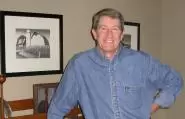Grandfathers and Quarterhorses

My second go-round as a cowboy ended Saturday morning.
My first began as a child when my mother, herself a local horse show queen, perched me atop my grandfather’s palomino quarterhorse for a photograph with him. Both were caught looking at the camera thinking “what is this baby doing up here?”
My grandfather taught me to ride, to drive a tractor, to bale hay, to straighten and save bent nails, and to always answer the question “Can I help?” with a nod, despite knowing he could do the task at hand twice as fast and twice as well without the assistance of a fumbling grandchild. He was a gifted teacher, though he rarely set foot in a classroom.
He had a soft spot for orphaned ponies sent to the sale barn every Wednesday to be auctioned off. Some went to new farms; others were destined for the dog food buyers. Grandpa Hickok knew who they were and if he thought a young pony with good potential was headed to the slaughterhouse, he always outbid them.
Our summer vacation ended each year with a local fair, rodeo and horse show, and grandpa always had a pony saddled and ready for each grandchild to ride in our particular class. My entry one sunny Friday afternoon coincided with the nearby go-cart races. As the group of us were slowly making our way around the show ring in front of the judges, a grandstand full of spectators and, of course, my neighborhood classmates, an engine backfired, sending my pony into a full gallop around the ring looking, as a horse in panic always does, for an escape route. I clung to the saddlehorn for dear life, but to that pony I was dead weight slowing down his getaway. With a couple of well-timed bucks, he sent me flying into the plowed dirt, unharmed but humiliated, as the adults chuckled and my classmates ran and hooted at me through the fence.
It took me about thirty years before I climbed aboard another horse and it was not until the past ten years that I really got comfortable in the saddle. But living here in the foothills of the Blue Ridge Mountains, where there are more hiking, biking and riding trails than one person could ever explore, provided me with ample opportunity to overcome my childhood trauma.
I eventually bought a golden palomino quarterhorse, just like the one I first rode with my grandfather, and together we began exploring those trails and learning along the way to trust each other. I named him Indy, because he had a fourth gear faster than any horse I had ever ridden and loved nothing better than to run flat out, full speed across an open field.
He wasn’t perfect, as he didn’t like to stand still for fresh shoes or wait long for me to get settled into my saddle. He just wanted to go. And the sooner and the faster the better. This summer, however, at just age ten, the spark went out of Indy’s eyes. Instead of running, he walked, and when walking became too painful, he just stood. He quietly let us poke and prod him, draw blood until he felt like a pin cushion, and run endless tests, but none of it mattered. Horses get cancer, too. So yesterday we took our final walk around the pasture, found a few treats in my pocket and some fresh grass under the board fence, then reluctantly nuzzled our final good-byes to each other.
Looking forward to a better next Monday.

Thanks for listening,
Bruce
“There’s nothing better for the inside of a man than the outside of a horse.” – Elbert Hubbard
Sign in a barn outside Taos, New Mexico: “When you don’t know what to do, let your horse decide.”
